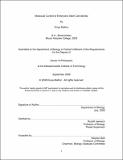| dc.contributor.advisor | Rudolf Jaenisch. | en_US |
| dc.contributor.author | Mathur, Divya, Ph. D. Massachusetts Institute of Technology | en_US |
| dc.contributor.other | Massachusetts Institute of Technology. Dept. of Biology. | en_US |
| dc.date.accessioned | 2009-09-24T20:46:28Z | |
| dc.date.available | 2009-09-24T20:46:28Z | |
| dc.date.copyright | 2008 | en_US |
| dc.date.issued | 2008 | en_US |
| dc.identifier.uri | http://hdl.handle.net/1721.1/46786 | |
| dc.description | Thesis (Ph. D.)--Massachusetts Institute of Technology, Dept. of Biology, 2008. | en_US |
| dc.description | This electronic version was submitted by the student author. The certified thesis is available in the Institute Archives and Special Collections. | en_US |
| dc.description | Includes bibliographical references. | en_US |
| dc.description.abstract | Embryonic Stem (ES) cells are the in vitro derivatives of the inner cell mass of a developing embryo, and exhibit the property of pluripotency, which is the ability of a cell to give rise to all cell lineages of an organism. Therefore, these cells hold great promise in the treatment of several degenerative diseases through patientspecific cell-based therapy. Consequently, a detailed knowledge of the factors regulating ES cell identity is required in order to exploit this therapeutic potential. In order to address this subject, genome-wide location analysis (or ChIP-chip) has been used to identify downstream genes that are bound, and potentially regulated by the key pluripotency transcription factors, Oct4 and Nanog. The data from this study have also been compared and integrated with Oct4 and Nanog DNA binding data obtained in a different study using the ChIP-PET technology. In order to gain further insight into the mechanisms by which the transcription factor Nanog regulates its downstream targets, an attempt at identifying proteins interacting with Nanog has also been described. Research on ES cells has been plagued with ethical controversies since the creation of these cells requires the destruction of embryos. Recent studies have reported the reprogramming of somatic fibroblasts into an ES cell-like induced pluripotent state (iPS) by virus-mediated transduction of four transcription factors-- Oct4, Sox2, c-Myc and Klf4, thereby circumventing the use of embryos in producing pluripotent cells.In these studies, selection for the activation of the markers Oct4 or Nanog led to completely reprogrammed cells, but selection for fbx15, a downstream target of Oct4, resulted in partially reprogrammed intermediates. An unresolved issue in the field was whether these intermediates were obtained due to early drug selection in the case of fbx15 selection, or because Fbx15 expression is not relevant to pluripotency. Drug selection for fbx15 activation at later time-points, and an examination of the methylation status of the Oct4 locus of Fbx15-iPS cells suggests that the intermediates were obtained due to early drug selection and not due to selection for fbx15. Therefore, these studies have begun to elucidate a framework that governs ES cell identity, and the mechanism by which a differentiated cell can be reprogrammed into a pluripotent state. | en_US |
| dc.description.statementofresponsibility | by Divya Mathur. | en_US |
| dc.format.extent | 181 leaves | en_US |
| dc.language.iso | eng | en_US |
| dc.publisher | Massachusetts Institute of Technology | en_US |
| dc.relation.requires | System requirements: CD-ROM drive. | en_US |
| dc.rights | M.I.T. theses are protected by
copyright. They may be viewed from this source for any purpose, but
reproduction or distribution in any format is prohibited without written
permission. See provided URL for inquiries about permission. | en_US |
| dc.rights.uri | http://dspace.mit.edu/handle/1721.1/7582 | en_US |
| dc.subject | Biology. | en_US |
| dc.title | Molecular control of embryonic stem cell identity | en_US |
| dc.type | Thesis | en_US |
| dc.description.degree | Ph.D. | en_US |
| dc.contributor.department | Massachusetts Institute of Technology. Department of Biology | |
| dc.identifier.oclc | 427036330 | en_US |
